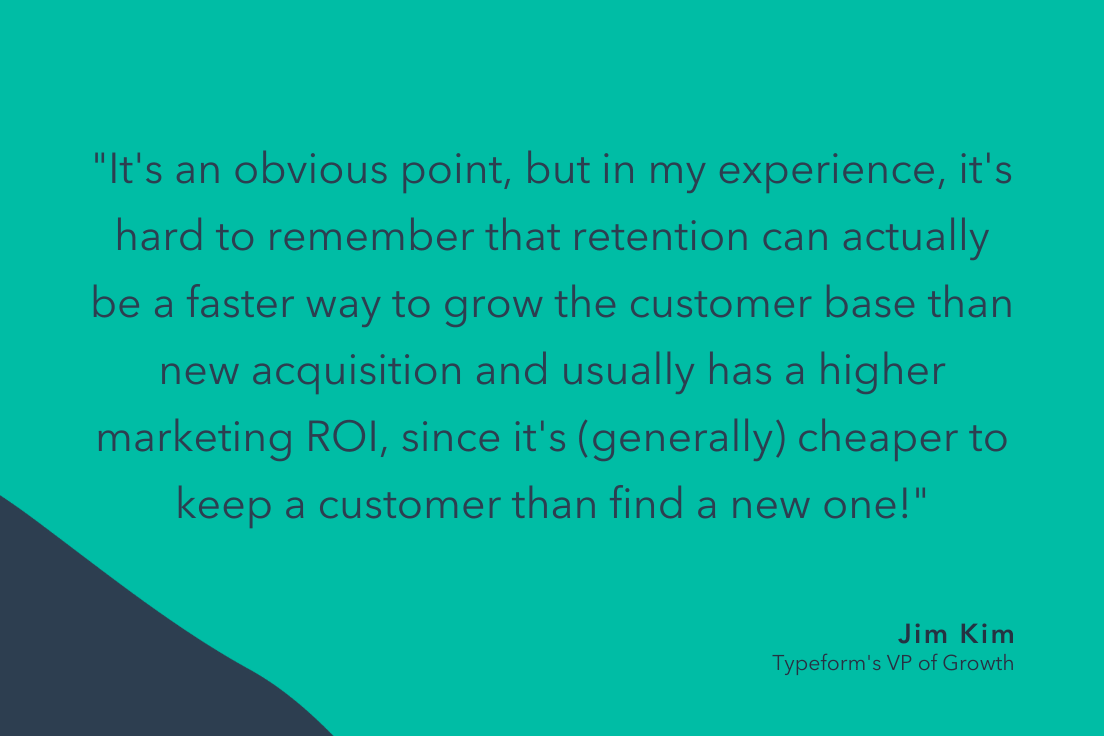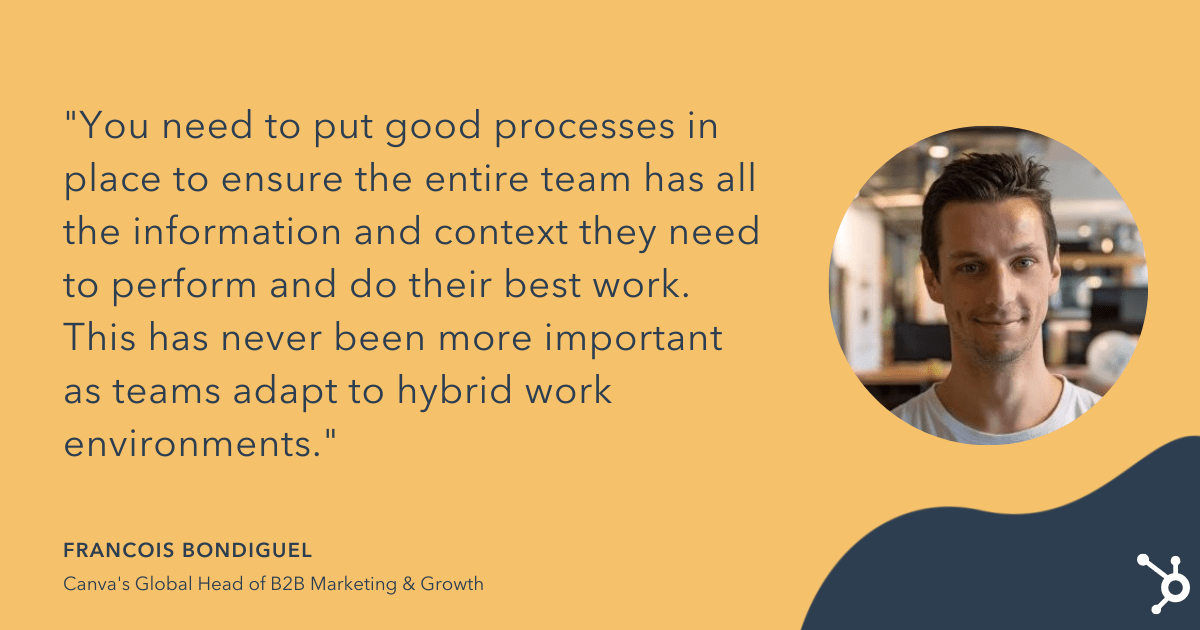- Like
- SHARE
- Digg
- Del
- Tumblr
- VKontakte
- Flattr
- Buffer
- Love This
- Save
- Odnoklassniki
- Meneame
- Blogger
- Amazon
- Yahoo Mail
- Gmail
- AOL
- Newsvine
- HackerNews
- Evernote
- MySpace
- Mail.ru
- Viadeo
- Line
- Comments
- Yummly
- SMS
- Viber
- Telegram
- JOIN
- Skype
- Facebook Messenger
- Kakao
- LiveJournal
- Yammer
- Edgar
- Fintel
- Mix
- Instapaper
- Copy Link
In 2020, I started using Headspace.
And, as it turns out, so did everyone else.
The meditation app, which was first launched back in 2012, initially generated roughly $30 million in revenue and, as of 2017, had 40,000 subscribers.
Today, the app has over 2 million users, and is valued at $320 million dollars. How’s that for growth?
But, when any company scales that quickly, it begs the question: Will the business survive, and even thrive under its newfound success? Or will it crumble?
Perhaps your company is experiencing similar growth, and your marketing team is feeling the growing pains. Or, maybe your business is brand new, and you’re focused on effectively building a strong marketing team for the first time.
Whichever the case, the challenges that come along with building or scaling a marketing team can be detrimental to an organization if handled poorly. Which is why I sat down with marketing leaders at Google, Microsoft, Wistia, Canva, and Typeform to learn their tips for successfully building or scaling a team — so that you’re ready when it’s your time to grow.
Let’s dive in.
Tips for Building an Effective Marketing Team
1. Hire with diversity, equity, and inclusion in mind.
There are countless benefits to diversity in the workplace – for instance, did you know organizations with a diverse leadership team have 19% higher revenue on average than companies with less diverse leaders?
Or, how about the fact that diverse teams can solve problems faster than cognitively similar people?
Suffice to say, diversity matters.
When building an effective marketing team, it’s critical to consider diversity, equity, and inclusion from the very beginning.
As Google’s Global Head of SMB Partnerships Marketing, Elana Chan, told me, “Hiring is the most important thing you’ll do as a leader — and that also means you need to think about DEI. It’s easy when we’re running fast to just ask people in our own networks to apply for open positions, but it’s worth it to diversify. Every study and even my own experience has proven that diversification and different points of view are important.”
Chan adds, “It takes longer to hire people who are outside of your natural network, but it’s worth it. You’ll get the right people for the job and also set the right tone across your organization. It’s important to walk the talk when it comes to DEI, not just when it’s convenient.”
When you’re first building out your team, you’ll want to ensure you incorporate DEI into your recruitment plans. To do this, consider writing inclusive job descriptions, advertise roles through diverse channels, and standardize your interview process.
You might also try using recruitment technology like Greenhouse Inclusion to reduce the risks of unconscious bias when interviewing.

2. Hire people who are hungry enough to try anything.
If you’re just starting out, you don’t have unlimited budget to hire a slew of marketers who specialize in various marketing activities. Instead, you likely only have the budget for a handful of marketers — or perhaps even just one.
So … how do you make that one hire count?
Above all else, Wistia co-founder and CEO Chris Savage believes it’s important to consider how driven your first marketing hire is.
He told me, “You want to find someone who is extremely hungry, and can make their own things — whether that is video, written content, or audio. Whichever assets your team needs, if you can find someone who can be both the creator and manager of those assets, then you unlock the ability to try things much more easily.”
“At Wistia,” he adds, “I hired a lot of misfits who were so hungry that they were willing to try anything. Maybe on paper it didn’t make sense, but in reality, it was incredible.”
For instance, perhaps your marketing team has identified YouTube as a viable opportunity to reach new audiences and convert those users into leads. If that’s the case, consider hiring someone with experience creating video — along with a strong desire to learn quickly, and try new things.
3. Hire a marketing customer experience (CX) leader.
When asked what the most crucial early hire on a marketing team is, John Cosley, Senior Director of Global Brand Marketing at Microsoft Advertising, told me: “Two years ago, I would have said a marketing data scientist — someone who can analyze datasets and help their organizations better understand their customers and identify future opportunities, as well as advise on marketing tactics and analysis methodologies.”
“Fast forward to today,” He adds, “And I would say that the marketing customer experience (CX) leader is the most crucial early hire in scaling a marketing team. Consumer journeys have increasingly become digital and multi-modal and expectations have increased around privacy and trust, personalization, and quality.”
If you’re interested in creating a customer experience strategy for your business, take a look at How to Define a Customer Experience (CX) Strategy.
Ultimately, a customer experience is about putting the customer first. As Cosley told me, “Consumers are more likely to value a brand that values them, so it has become critical for brands today to prioritize the customer experience all the way through the purchasing funnel.”
4. Hire early.
Hiring as you’re scaling can be a bit like trying to build a plane while you’re flying it.
It can be difficult and messy to get new hires up-to-speed at the same time you need them to perform optimally so your consumers don’t feel the friction. To minimize these challenges, consider hiring months ahead of when you’ll need certain roles filled.
As Francois Bondiguel, Canva’s Global Head of B2B Marketing & Growth, told me, “A big challenge that many face as they scale is getting the organizational structure and strategy right. This includes hiring the right people, and ensuring they have leaders in place to guide them through this transformative phase and help them remove roadblocks so they can move fast.”
“On that note,” Bondiguel adds, “it’s important for key hires to be brought in early to ensure they are properly onboarded prior to projects ramping up. This helps avoid placing unrealistic pressure on new team members as well as the broader group.”
To do this effectively, take a look at your team’s long-term vision, and brainstorm which role(s) will need to be filled to get your team to the next level.
5. Use one data set to guide your entire department.
When you’re first starting out, I’m willing to bet your lean startup team understands the importance of making data-based decisions … but they likely also work in silos.
Maybe you have two content strategists who focus on lead generation numbers. Then, perhaps you have another social media marketer who focuses on cost-per-acquisition.
The issue? “When you’re operating in silos, there are also data silos,” Chan tells me. “Which means you can never pull the same number across teams. That’s a mistake. If you start off providing your team with a unified data set, then it’s easier to grow together. It’s much harder to merge data sets later, and then it becomes politics to determine the right numbers to use.”
To fix this, ensure you have a unified system for collecting and analyzing data even when your team is small. Consider using a CRM to store your data in one place, or creating a department dashboard in Google Analytics.
Whatever the case, it’s vital you provide your team with a centralized location so your data processes can grow with you as you scale.
6. Focus on customer retention in the beginning, rather than just customer acquisition.
When you start to see your list of customers growing, it can be tempting to want more, more, more.
But as a startup, you need to be careful. If you focus exclusively on acquiring new customers, you forget one of your strongest weapons — your existing customers.
As Typeform’s VP of Growth, Jim Kim, told me, “Many SaaS-based startups … focus exclusively on customer acquisition and tend to neglect customer retention until they see issues with the customer base size growing.”
Kim adds, “By focusing early on efforts to engage and retain the base of customers already acquired, the startup develops a more holistic understanding of the customers they serve, and can gain insights into the things customers really care about that can then be added to the acquisition activities.”
To prevent customer churn, you’ll want to build out an incredible customer support strategy that enables your existing customers to get their needs met. Additionally, consider how you might provide value beyond the purchase, or create a personalized customer experience so your customers know you care about them.
As Kim points out, “It’s an obvious point, but in my experience, it’s hard to remember that retention can actually be a faster way to grow the customer base than new acquisition and usually has a higher marketing ROI, since it’s (generally) cheaper to keep a customer than find a new one.”

Tips for Scaling Your Marketing Team
1. Don’t stifle the energy of a startup.
As you begin to scale, the workplace inevitably changes. Before, conversations happened casually across office desks, or when grabbing a cup of coffee — now, there are formal meetings with agendas.
And, while you could previously test out a new idea without necessarily requiring buy-in from leadership, now you’re expected to follow stricter processes, which limits the experiments you can try.
And yet, one thing shouldn’t change as you scale.
As Chan puts it, “It’s important not to stifle the energy of a startup. That’s the exciting part of being where you are, and I think the acknowledgement that you’re building the car as you’re driving it is okay — and fun.”
Chan adds, “At Google we have a saying: ‘Operating at the edge of chaos’. If you imagine a frontier, one side is not enough chaos, and the other side is too much chaos. If there’s too much chaos, no one knows what’s happening, and nothing gets done. But if there’s not enough chaos, then there’s no innovation and you’re not moving forward.”
“It’s your job as a leader to operate as closely to this frontier as possible, and I think in a startup that’s even more true.”
When you begin to scale, you’re going to need to implement more formal processes. But these processes shouldn’t restrict your employees from taking risks, testing out new ideas, and pushing the boundaries of your marketing efforts.
Consider, as you scale, how you can protect that “startup energy” at all costs.
2. Stick with what’s working.
As you begin to scale, you’re probably looking for new growth opportunities. And, at this point, it might feel like the sky is the limit — your business is rapidly growing, so why not take some risks?
But, while certain risks are inevitable, it’s not a good idea to expand too far beyond what’s already working.
As Savage told me, “If you’re a startup that’s making progress in terms of bringing in customers and getting them to use your product or service, then it’s easy to think, ‘Okay, I have one channel that’s working … now let’s add a channel on top of that, and another channel on top, and that’s how I’ll scale.’ Like, PR is working, why not add paid advertising on top?”
The mistake, Savage says, is that there are often one or two channels you end up underestimating in terms of growth potential. If your content is performing exceedingly well and driving leads for the business, it’s not necessarily a good idea to pivot away from content. Instead, you want to ask yourself — How much more can we expand with our content?

“There’s good advice in personal finance,” Savage says, “which states that most wealth is built through a concentration of risk, and it’s maintained through a distribution of risk — so, basically, if you want to become wealthy, you need to take just a few big risks.”
“It’s the same thing when scaling customer acquisition … There are a few big things you can do. It’s very important to go big on the things that are already working.”
Rather than investing in social media, digital marketing, video, PR, and blogging all at once, consider which channels drive the most leads for your business. Those are the channels that got you this far, and those are likely the same channels that will get you even further if you focus your efforts.
3. Treat your culture as a business priority.
It’s easy enough to foster and maintain a strong culture when you’re a small team. But, as you scale and expand your team, it can get harder to protect the culture that attracted employees to your office in the first place.
And while culture might just sound like a buzzword used to replace beer garden and yearly ski trips, it’s not.
In reality, culture is vital to your business’ success — in fact, companies with strong cultures are 1.5X more likely to report average revenue growth of more than 15% over three years.
As Cosley told me: “In any growing organization, the key to success is embracing and honoring the culture to which you aspire. It’s likely what made your company a great place to work and attracted the high-quality talent that is driving your growth.”
Cosley adds, “It’s not hard for core values and cultural priorities to erode or even get lost during expansion if that work is not made a priority. As you scale, you’ll want to think and act intentionally about how your culture grows with you, how you define and memorialize it, how it impacts your hiring and onboarding, how you train your leadership, and how you evaluate performance.”
Keep in mind — whether or not you’ve actively fostered it, your company already has a culture … it just might not be a strong one. And strong cultures can both attract and retain employees for the long-run, so it’s an important business initiative to take the time to create one that aligns with your values and purpose.

Additionally, Cosley notes, “Culture is not one-dimensional. You need to consider it across areas such as retention and hiring, diversity and inclusion, and employee engagement. And culture is contagious. Not only does it deliver more positive outcomes and business results, it helps with critical talent retention, and can lower the cost and time to acquire new talent.”
“Treating your culture as a business priority is essential. Without doing so, it could be detrimental to your organization’s potential.”
To ensure your culture grows with your organization as you scale, take a look at HubSpot’s Ultimate Guide to Company Culture.
4. Institutionalize key values on your team.
To build a strong team culture, Chan recommends institutionalizing key values.
For instance, perhaps you value autonomy, empathy, adaptability, or intellectual growth. As a leader, it’s vital you use these values as foundational building blocks on which your team can grow.
Chan told me, “For me, learning and intellectual curiosity are really important, so I say to my team, ‘You’re responsible for making the person next to you smarter’. And that creates the onus on bringing your own best game because everyone around you is so incredibly talented — so how are you being additive, collaborative, and innovative from within that culture? You owe it to each other to be your best.”
5. Praise what’s right … and punish what’s wrong.
Once you’ve identified the values that matter to your organization, it’s vital you encourage those values in each of your employees.
When providing performance reviews, for instance, take the time to identify where employees have demonstrated key team values, and where they might still be lacking.
As Savage told me, “The way you scale it is, you praise the right stuff and punish the wrong stuff. It’s that simple — most culture is modeled. You need the most senior people to act the way you believe you should be acting, and if you do that, it permeates the building.”
As an example, let’s say you value risk-taking on your team. If that’s the case, you’ll want to praise your team when they take risks, and even praise the failure that might result from those risks.
Alternatively, if you’re in a mode where you’re risk-averse and looking for optimization of processes, you’d want to praise actions that demonstrate risk management.
6. Hire for the future — not just today.
Finally, when you’re scaling, you want to consider who you can hire today that will continue to meet the needs of your business even as those needs change over time.
For instance, when I was first hired at a startup, I was hired to create blog content. Fast-forward six months, and I was additionally tasked with creating a podcast, and increasing the subscriptions to an email newsletter. As the business scaled, my role changed quickly. So it’s vital you hire with the future in-mind.
When asked about the biggest challenge leaders face when scaling, Kim told me, “[It’s] the challenge to balance long-term and short-term hiring. For a larger, more established business, scaling a team is not as challenging. The roles are already clearly defined, and there is likely already someone doing that job. It’s easy to hire for a role like this.
“But,” Kim adds, “when the team is trying to scale, the roles may be less clear and transitory. What you think you need today could be wildly different tomorrow. Balancing the needs of today, while keeping an eye out on how things might change in the future is something that’s extremely hard to do.”
Hiring and recruiting isn’t an easy task, but to ensure you’re hiring for the future, you’ll want to take the time to determine someone’s work ethic, flexibility, and ability to shift roles as the needs change. And, as mentioned above, you’ll want to find someone who’s hungry to be there.
7. Create processes for effective communication.
As your team scales, it becomes even more important to ensure you have processes in-place to ensure fair, effective cross-team communication.

For instance, perhaps you’ve noticed your meetings have become opportunities for your most extroverted employees to share their successes, while the majority of your team stays silent.
To combat this, consider creating a meeting agenda or slide deck, so people know what they need to share, and when.
As Bondiguel puts it, “Another challenge is communication. You need to put good processes in place (access to documents, meeting cadence, etc.) to ensure the entire team has all the information and context they need to perform and do their best work. This has never been more important as teams adapt to hybrid work environments.”
And there you have it. Whether you’re officially in the scaling phase or still in the startup phase, these tips should help you ensure you’re building a strong foundation for the future.
Originally published Sep 17, 2021 12:00:00 PM, updated September 17 2021




